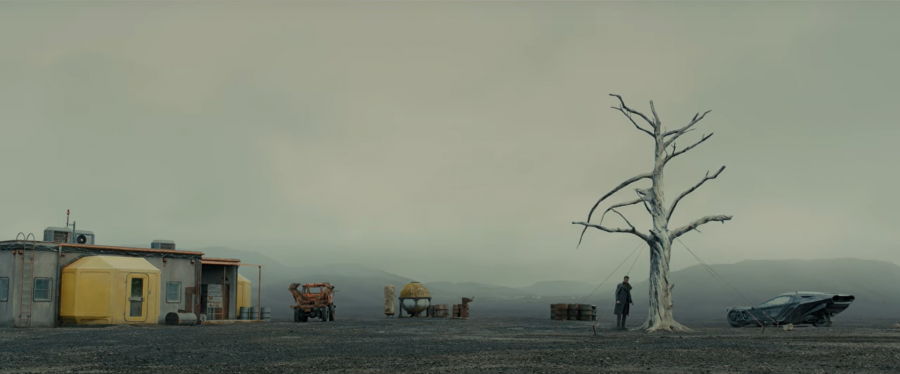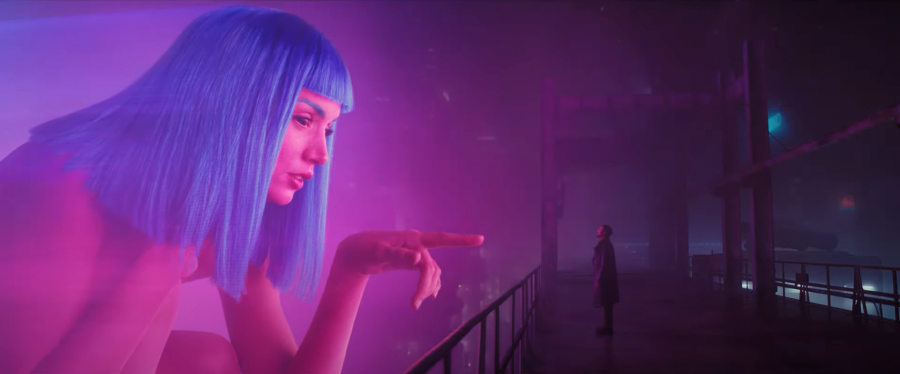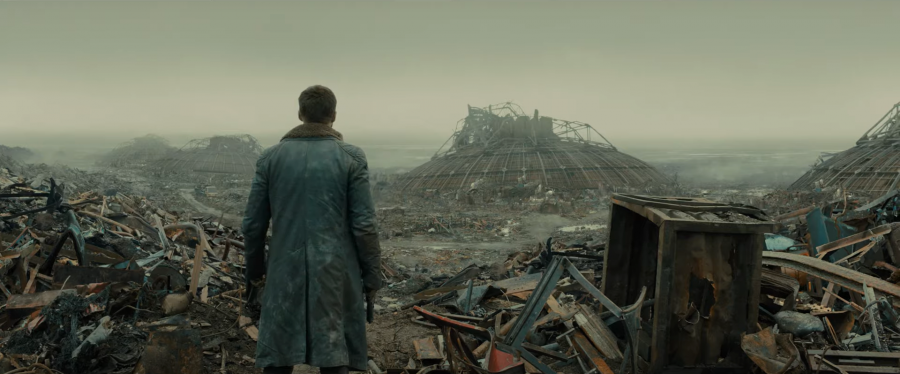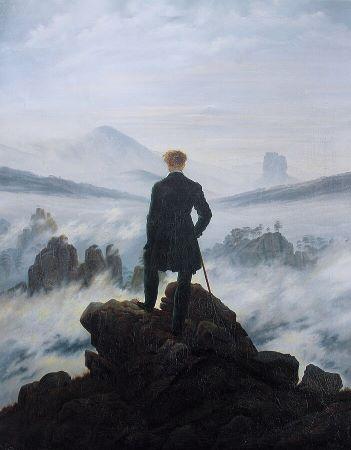
Experiencing the Sublime in Blade Runner 2049
Dystopian cities, human replicants, ecological collapse—these futuristic elements compose the story world of Blade Runner 2049. Released in 2017, this neo-noir science fiction film tells the story of Blade Runner 'K' as he discovers a dark secret that, if exposed, holds the power to disrupt society. As indicated by the title, the story takes place in 2049, when technology has become so advanced that the lines between physical and digital became blurred: AI-driven humanoid robots are almost inseparable from real humans; memories can be created using Virtual Reality; and the protagonist K feels emotionally connected to a holographic girl.
Moreover, human impact has led to extreme pollution and the general collapse of nature—the only trees we see are either long-dead or VR-generated. What results from such ingredients is a grim dystopian atmosphere that captivates the viewer, immersing them into this post-apocalyptic world. This experience is greatly enhanced by the remarkable style of the film. The wide shots present beautiful but haunting images of desolate landscapes and neon-lighted cities, complemented by an ominous soundtrack that is often unsettling.
Besides, although the story is set in an eerie environment, it contains a hopeful plot about what it means to be human in a technology-dominated world. In that sense, director Denis Villeneuve has created an intricate film: one that simultaneously shows despair and hope. This paradox—of feeling both fear and admiration; of being both overwhelmed and elevated—is inherent to the concept of the sublime. But what exactly does the sublime entail? And how does this notion relate to the film? In this paper, I will analyse Blade Runner 2049 through the lens of the sublime. I will first define the concept, after which I will introduce the case more broadly. Finally, I will analyse the film and argue how it can evoke feelings of sublimity.
What is the Sublime?
Although the sublime has been discussed for centuries by various philosophers, theorists, artists, and writers, it has no exact definition. Rather, it is a concept open to different approaches. In his book The Sublime (2017), Philip Shaw offers historical overviews and explanations of these approaches. In the first chapter, he defines the sublime as an experience that goes beyond words: “Whenever experience slips out of conventional understanding, whenever the power of an object or event is such that words fail and points of comparison disappear, then we resort to the feeling of the sublime.” (p. 2).
So, when the ability to express a thought is defeated, it is through this very defeat that we get a glimpse of what lies beyond thought and language, resulting in a sublime experience. Describing it as an encounter with the limit of human understanding, Shaw underlines the paradoxical nature present in the key theories of sublimity: being simultaneously overwhelmed and exalted; both diminished and enlarged. In other words, the sublime is about feeling inferior and superior to the transcendent in art or nature—about painful pleasures.
When the ability to express a thought is defeated, it is through this very defeat that we get a glimpse of what lies beyond thought and language, resulting in a sublime experience.
The emphasis on pleasure and pain can be traced back to Irish philosopher and politician Edmund Burke, who wrote about the concept in his work A Philosophical Enquiry into the Origin of Our Ideas of the Sublime and Beautiful (1757). In it, he separates the sublime and the beautiful, arguing that while the sublime “dwells on great objects, and terrible”, the beautiful addresses “small ones, and pleasing” (p. 163). The sublime is greater than the beautiful; it is dark, profound and overwhelming, rather than light, fleeting and charming (Shaw, 2017). In sublimity we are forced, Burke concludes, whereas in beauty we are flattered: “We submit to what we admire, but we love what submits to us” (p. 163).
With his book, Burke highly contributed to the discourse on sublimity in the Romantic period, as did other influential figures such as German philosopher Immanuel Kant. When writing about the sublime, Kant (1790) expressed that nature, as tangible material, can be beautiful but not sublime: “What is sublime (…) cannot be contained in any sensible form but concerns only ideas of reason” (p. 99). Sublimity transcends sensory perception and is thus not about what we perceive, but about how we comprehend it.
The sublime originates in the subject’s mind, Kant stresses, not in the object of nature. This shift of focus—from nature to the mind of the spectator—can also be recognized in the Burkean sublime. In his definition, Burke (1757) emphasizes the psychological effects of terror, stating that the source of the sublime lies in “whatever is in any sort terrible, or is conversant about terrible objects, or operates in a manner analogous to terror” (p. 45).
Terror and danger cannot be fully captured in our minds, he argues, and are therefore sublime. However, what is crucial to his definition is our distance from what is terrifying, as it mitigates the threat. That is, we can only feel delight at certain distances from actual danger because when it presses too nearly, it becomes incapable of giving us any pleasure. So, as long as terror is kept at a safe distance and forms an object of contemplation, we can experience a sublime sensation.
The Story and Setting of Blade Runner 2049
Before relating Blade Runner 2049 to the notion of the sublime, let us look at the film in more detail. As mentioned, the story is set in 2049, in a dystopian future where bioengineered human replicants serve humans but are treated as second-class citizens. We follow replicant 'K', who works as a Blade Runner and whose job is to ‘retire’ (i.e., kill) replicants of older, less advanced generations. On one of his missions, he uncovers an obscure secret: he finds evidence suggesting a replicant has given birth, contradicting the belief that these beings cannot reproduce. He embarks on a quest to seek answers about the child’s identity, during which he faces obstruction from powerful societal entities who want to hide the truth.
Having no family and friends as a replicant, he finds emotional support in Joi, his holographic AI companion, while facing the complexities that arise when the line between human and artificial life blurs. During his journey, K is confronted with his own identity and humanity and starts to question the essence of memory, emotions, and what it means to be alive. So, considering its plot, Blade Runner 2049 is fundamentally a hopeful story about purpose; about what it means to be human in a world dominated by technology.
By depicting advanced technology in a collapsed world, the film presents a hyper-realistic vision of a future marked by both progress and decline.
What contributes significantly to the dystopian atmosphere of the film is its environmental setting. The story takes place in a post-apocalyptic world, decades after the planet’s ecosystems collapsed in the mid-2020s. This led to a worldwide famine that killed millions—a disaster to which synthetic farming became the solution (IMDb, n.d.). Greenery is absent throughout the film, which instead shows a planet overpowered by urbanization and industrialization.
This is highlighted by the visuals that capture pollution and worn-down landscapes, emphasizing the consequences of human actions on the environment. So, although it does not directly address climate change, the film hints at its impact. Besides, by depicting advanced technology in a collapsed world, it presents a hyper-realistic vision of a future marked by both progress and decline. All in all, while Blade Runner 2049 does not revolve around a catastrophic natural event, the post-apocalyptic setting paints a daunting picture of a planet in decay, serving as a cautionary tale about the threat human beings form to the environment.
The impact the film has is greatly enhanced by its cinematic elements. For example, consider the cinematography: detailed, wide shots capture the vastness of the dystopian cities and landscapes, immersing the viewer in the futuristic world. Including bright colours and stunning visual effects, they evoke the film’s exceptional atmosphere.
The visuals are complemented by an eerie soundtrack that builds tension and, using electronic sounds, adds to the dystopian setting. Finally, the slow pace of the film and its specific moments of silence increase audience immersion and overall enhance the mood of the story. Together, these cinematic elements establish the dystopian setting of Blade Runner 2049 while also accentuating the emotional themes of the story.

Figure 1. Blade Runner 2049 (2017). K on his mission to ‘retire’ a human replicant.
The Sublime in Humanity and Technology
Having discussed the theory on sublimity as well as the story and setting of Blade Runner 2049, how can we connect these two elements? In other words, how does the film evoke a sublime experience? Let us first explore how the story deals with the theme of humanity. As described above, Blade Runner 2049 is essentially a film about being human in a collapsing, technology-dominated world. We follow the protagonist K, who, after finding the evidence suggesting a replicant-born child, starts to grapple with his humanity, asking himself what it means to be alive. Is he the child he is looking for? Does that mean he has a soul? What is it that makes us human? These questions extend to us viewers, as we follow K in his existential crisis, knowing as few answers as he does.
The film ends when he reunites the lost family members—a father and a daughter—after which we see him dying at peace with the good he did. This open ending has not given answers to many of K’s overwhelming questions, thus leaving them with us. The film, then, becomes an object of contemplation, making us think about what defines and drives humanity. Moreover, K’s final moments lead us to ponder whether we would act similarly in his situation, asking ourselves what we would die for. Such questions about life and death evoke a sense of terror, Eagleton (2005) argues, which can bring us close to a sublime experience. We undergo our destruction in the film rather than in reality, so we live out a virtual kind of death, confronting us with our unavoidable fate. This elicits a feeling that is shattering, ravishing, exhilarating, overwhelming, terrifying and uplifting; a sublime feeling, (Eagleton, 2005).
The film becomes an object of contemplation, making us think about what defines and drives humanity.
Not only does Blade Runner 2049 spark questions about life and death, but it also explores the fading line between the fake and the real. In the storyworld, society consists of humans and human replicants, as well as humanoid holographic robots like Joi. The film thus depicts people living together with advanced technology and shows how this blurs the boundary between real and artificial life. This provokes deep questions about the consequences of technology for humanity's future, which we cannot comprehend or answer. In other words, their extent is so overwhelming that it exceeds our understanding, thus making the experience sublime (Shaw, 2017).
A fundamental detail here is the distance between our and K’s reality. According to Burke (1757), we cannot experience delight if the terror we see on screen presses too nearly. For instance, we recognize technological features like location tracking and facial recognition, but the daunting futuristic AI technology is too advanced to relate directly to our reality. The dread of Blade Runner 2049’s hyperreal dystopia thus remains at a safe distance; it does not invade our everyday lives. This allows us to contemplate the grandeur of the storyworld without experiencing it, heightening our feelings of sublimity.

Figure 2. Blade Runner 2049 (2017). K standing in front of a holographic advertisement of AI robot Joi.
The Sublime in Ecological Collapse
Another aspect of Blade Runner 2049 that can evoke feelings of sublimity is its dystopian atmosphere. Though not a story about climate catastrophe itself, the film portrays life after the 2020s ecosystem collapse has struck the earth. It thus depicts a post-apocalyptic world, where humans have found a new way to exist without nature. This dystopian portrayal of our planet can encourage a particular feeling, one similar to Salmose’s (2018) apocalyptic sublime.
We encounter the apocalyptic sublime, he suggests, when a film creates an experience in our bodies and minds through immersion in the severe threats of climate change. It goes beyond the Romantic sublime, incorporating existential angst where diegetic humans become the victims, rather than mere observers (Salmose, 2018). While disaster and its victims are not directly depicted in Blade Runner 2049, we can undergo a comparable experience when seeing the aftermath of the natural collapse.
We observe the terrifying transformation our planet has gone through by the year 2049, leading us to contemplate the immense consequences of potential environmental disruption. The film raises existential concerns about a world decaying because of human action, making us ponder—from a safe distance—the profound and frightening effects of our impact on the planet. This experience surpasses human understanding and, as a result, evokes overwhelming feelings of awe and dread that are inherent to the sublime.
The Sublime in its Cinematography
In this last section, let us dive into the cinematic elements of Blade Runner 2049 as a source of the sublime, in particular its cinematography. As became clear from the previous sections, the film arouses overwhelming sensations and deep questions—experiences that are intensified by the striking visuals of the film. For example, cinematographer Roger Deakins utilized captivating lighting techniques, adding neon lights to smog-filled cities, which reinforces the dystopian mood of the story. The bright holograms in the urban environment display brands we know from our reality, such as Sony and Coca-Cola, giving us an unsettling feeling of recognition, as if it brings the story closer to ours.
Moreover, capturing the natural collapse of our home planet, the wide shots of the bleak landscapes elicit an overwhelming sense of emptiness that makes us feel both admiration and horror. Here, the human is often placed at the center of the frame, usually with his back towards the camera—a technique also used by Romanticist landscape painter Caspar David Friedrich, whose work is commonly associated with the sublime.
Consider, for instance, his painting Wanderer above the Sea of Fog (1818): the man’s presence emphasizes nature’s vastness in comparison to humans, while his position allows us to take on his point of view. Looking at the visuals of Blade Runner 2049, we can thus clearly see similarities with the Romantic sublime in art—their haunting beauty leaves us terrified and in wonder. All in all, the film’s thought-provoking cinematography, combined with the soundtrack and pacing, highly engages us in the story, thereby heightening our experiences of sublimity.

Figure 3. Blade Runner 2049 (2017). K roaming the area of “San Diego”, a desolate and heavily polluted place.

Figure 4. Caspar David Friedrich. (1818). Wanderer above the Sea of Fog. [painting]. Hamburger Kunsthalle, Hamburg, Germany.
Conclusion
In short, this paper analyzed Blade Runner 2049 through the lens of the sublime. Considering various writers’ definitions of the concept, I explored how the film can evoke feelings of sublimity. Essentially, my analysis has shown that Blade Runner 2049 elicits profound questions about what defines humans, and what it means to be alive and die. Moreover, watching K’s story unfold in a decaying world where the physical and digital are fused makes us ponder the consequences of human impact on the environment, as well as the effects of advanced technology on our society.
So, the film inspires us to reflect upon our humanity and our connection to the planet—an experience that is heightened by the sensational cinematography. Implementing artistic techniques similar to those in sublime paintings from the Romantic period, the fascinating visuals immerse us in the story. They skillfully capture the dystopian setting, juxtaposing survival and destruction, human and technology, and the familiar and strange, thereby heightening the sublime interplay between hope and despair.
Blade Runner 2049 inspires us to reflect upon our humanity and our connection to the planet—an experience that is heightened by the sensational cinematography.
What also intensifies the feelings of sublimity is the distance that is crucial to the Burkean definition of the concept. That is, the terrifying events that are depicted in the film are not experienced directly: we see the frightening effects of ecological collapse, rampant urbanization, and futuristic technology—yet this dystopian image remains safely separated from our everyday lives. Altogether, these aspects make the Blade Runner 2049 an object of contemplation.
The overwhelming themes evoke thoughts and feelings that exceed our limits of understanding; that are incomprehensible and inexpressible. We experience painful pleasures: paradoxical feelings of horror and admiration, fear and wonder, and intimidation and elevation. We experience a state beyond thought and language—in other words, we experience the sublime.
References
Burke, E. (1757). A Philosophical Enquiry into the Origin of Our Ideas of the Sublime and Beautiful.
Eagleton, T. (2005). Holy Terror. Oxford University Press.
Friedrich, C. D. (1818). Wanderer above the Sea of Fog. Hamburger Kunsthalle, Hamburg, Germany.
IMDb. (n.d.). Blade Runner 2049. Retrieved from IMDb.
Kant, I. (1790). Critique of Judgment.
Salmose, N. (2018). The Apocalyptic Sublime: Anthropocene Representation and Environmental Agency in Hollywood Action-Adventure Cli-Fi Films. The Journal of Popular Culture, 51(6), 1415-1433.
Shaw, P. (2017). The Sublime (2nd ed.). Routledge.
Villeneuve, D. (Director). (2017). Blade Runner 2049 [Motion Picture].